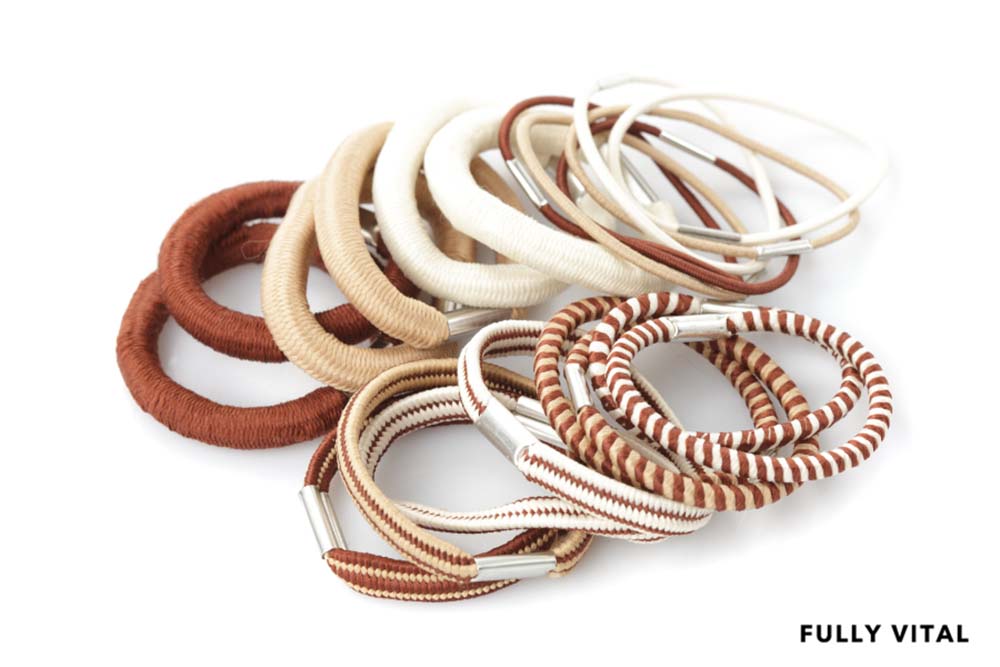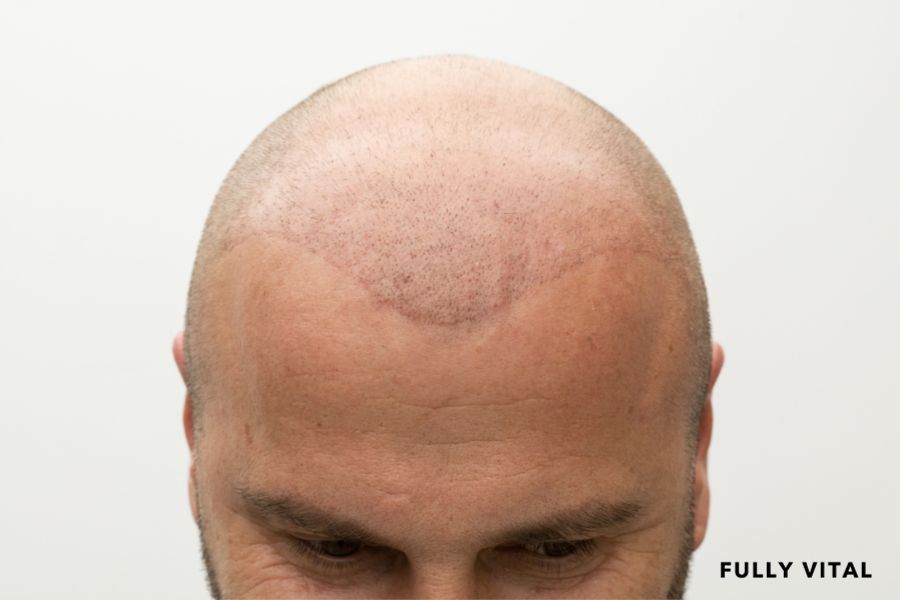
Everything You Need To Know About Hair Elastics
In our quest to provide comprehensive information on all things related to hair growth, we understand the importance of covering every aspect of hair care. Today, we dive into the world of hair elastics and explore what they are, why they matter, how they work, their benefits, potential downsides, and alternative options. Whether you have fine, curly, or straight hair, this article is tailored for women of all hair types looking to stimulate hair growth.

I LOVE MY HAIR NOW
FullyVital hair serum and hair vitamins made tremendous improvements in my hair. I truly love my hair now.
Dorit S.,
What Are Hair Elastics?
Hair elastics, also known as hair ties or hair bands, are small but essential accessories used to secure hair in various styles, such as ponytails, buns, and braids. These elastic bands are typically made from materials like rubber, silicone, or fabric and come in different sizes, colors, and designs to suit your styling preferences.

Why Are Hair Elastics Important?
Hair elastics play a crucial role in hairstyling and daily hair care routines. They help keep your hair in place, preventing it from falling into your face and eyes. By securing your hair neatly, hair elastics also reduce tangles and breakage, which can contribute to healthier hair in the long run.
How Do Hair Elastics Work?
Hair elastics work by gathering your hair and holding it together in a specific style. When you wrap an elastic band around your hair, it creates tension, which keeps your hair in place. This tension is what allows you to create various hairstyles, from tight ponytails to loose buns.(1)
What Are The Benefits Of Hair Elastics?
- Versatility: Hair elastics offer versatility in styling, allowing you to experiment with different looks effortlessly.
- Hair Protection: They protect your hair from environmental factors, such as wind and pollution, which can lead to damage.
- Convenience: Hair elastics are easy to use and can quickly transform your hair from a casual look to an elegant one.
- Prevent Hair Breakage: By securing your hair gently, they help prevent hair breakage and split ends.
Are There Any Downsides To Hair Elastics?
While hair elastics have many advantages, it's essential to be mindful of potential downsides:
- Hair Damage: Tying your hair too tightly with elastics can cause stress on your strands and lead to damage.
- Breakage: If not removed carefully, hair elastics can pull and break your hair.
- Tangles: Overusing elastics can create tangles and knots in your hair.
- Hygiene: Dirty or worn-out elastics can accumulate bacteria and oil, which may affect hair and scalp health.(2)
What Are The Alternatives To Hair Elastics?
If you're concerned about the potential drawbacks of traditional hair elastics, consider these alternatives:
Scrunchies
These fabric-covered hair ties are gentler on your hair and come in various colors and patterns.
Claw Clips
Claw clips secure your hair without the need for bands, reducing tension and potential damage.
Spin Pins
These spiral-shaped pins are perfect for holding updos in place with minimal stress on your hair.
Bobby Pins
Ideal for securing smaller sections of hair, bobby pins are versatile and can be used in a variety of styles.
Choosing The Best Elastics For Your Hair
When it comes to hair elastics, not all are created equal. Selecting the right ones can make a significant difference in the health and appearance of your hair. Here's what you need to know:
Types of Hair Elastics
There are several types of hair elastics available, each with its own set of benefits and drawbacks. Consider the following options:
- Traditional Elastic Bands: These are the most common hair elastics and are typically made from rubber or silicone. They provide a secure hold but can potentially cause damage if used too tightly or frequently.
- Cloth-Covered Elastics: These elastics have a fabric covering that reduces friction and minimizes hair breakage. They are a gentler option for your hair.
- Scrunchies: Scrunchies are fabric-covered hair ties that are less likely to leave creases in your hair. They offer a more comfortable hold and are excellent for preventing damage.
- No-Crease Elastics: These elastics are designed to prevent creases and kinks in your hair, making them a good choice for those who frequently change hairstyles.
Are Elastics Good for Your Hair?
The answer depends on how you use them and the type of elastics you choose. When used properly, elastics can be a valuable tool for hairstyling. However, there are some considerations to keep in mind:
- Gentle Hold: Opt for elastics that provide a gentle, yet secure hold to minimize hair damage.
- Avoid Tight Styles: Avoid pulling your hair too tightly when using elastics to prevent stress on the hair shaft.
- Regularly Replace: Replace your elastics regularly, as worn-out elastics can lose their elasticity and cause damage.
Do Hair Elastics Damage Hair?
Hair elastics can potentially damage your hair if not used correctly. Here are some factors to be aware of:
Potential Damage Factors
- Tension: Tying your hair too tightly with elastics can cause stress on the hair shaft, leading to breakage.(3)
- Frequency: Frequent use of elastics, especially tight ones, can contribute to hair damage over time.
- Worn-Out Elastics: Using elastics that have lost their elasticity can snag and break your hair.
Tips to Prevent Damage
- Choose Wisely: Opt for hair elastics that are gentle on your hair, like cloth-covered or scrunchie-style elastics.
- Avoid Tight Styles: When creating hairstyles, ensure that your elastics are not too tight to reduce tension on your hair.
- Replace Regularly: Replace your elastics when they show signs of wear to maintain their effectiveness.
Are Scrunchies Better Than Hair Elastics?
Scrunchies and traditional hair elastics serve different purposes, and whether one is better than the other depends on your needs and preferences.
Scrunchies
- Gentler Hold: Scrunchies provide a gentler hold on your hair, reducing the risk of breakage and creases.
- Hair-Friendly: The fabric covering on scrunchies is less likely to cause friction and damage to your hair.
- Comfortable: Scrunchies are comfortable to wear, making them a popular choice for daily use.
Traditional Hair Elastics
- Secure Hold: Traditional elastics offer a more secure hold, making them suitable for active lifestyles and intricate hairstyles.
- Versatile: They come in various sizes and styles, allowing you to create a wide range of hairstyles.
Ultimately, the choice between scrunchies and traditional elastics depends on your hair type and the style you want to achieve.
Is It Okay To Sleep With Elastics In Hair?
Sleeping with elastics in your hair can be convenient, especially if you want to maintain a specific hairstyle. However, there are some considerations to ensure it doesn't lead to hair damage:
- Loosen Tension: If you plan to sleep with elastics, make sure they are not too tight to avoid stressing your hair while you sleep.
- Use Scrunchies: Opt for scrunchies or cloth-covered elastics, as they are less likely to leave creases or tangle your hair.
- Consider Protective Styles: Braiding your hair or using loose bun styles with gentle elastics can minimize the risk of damage.
Experience The Power Of Healthy, Youthful HairAt Fully Vital, we're on a mission to transform your hair care journey. Our science-backed hair growth products are designed to combat the effects of aging on your locks. Key Features and Benefits:
Unlock the secret to healthier, more youthful hair with Fully Vital. Discover the transformation today! |
Final Thoughts On Hair Elastics
We've explored the world of hair elastics, from understanding their types and benefits to addressing concerns about potential damage. We've also answered your most pressing questions, helping you make informed choices when it comes to caring for your hair.
At Fully Vital, we're dedicated to helping you maintain a healthy and vibrant mane. Our range of hair growth products is designed to combat the effects of aging on your hair, ensuring you have a thriving and beautiful relationship with your locks. If you're looking to enhance your hair care routine and support your hair's vitality, don't hesitate to explore our product offerings.
Remember, your hair deserves the best, and with Fully Vital, you can achieve just that. Here's to healthier, more beautiful hair!
Frequently Asked Questions About Hair Elastics
Can hair elastics cause hair loss?
Hair elastics can potentially contribute to hair loss if used too tightly or frequently. It's essential to use them with care and avoid putting excessive strain on your hair.
How often should I replace my hair elastics?
It's a good practice to replace your hair elastics regularly, especially if they show signs of wear and tear. This helps maintain their elasticity and prevents breakage.
Are there specific hair elastics for different hair types?
Yes, there are hair elastics designed for different hair types. Some are gentler on fine or curly hair, while others provide a stronger hold for thicker hair.
Can I use hair elastics for overnight hairstyles?
Using hair elastics for overnight styles like loose braids or buns can be convenient. However, make sure they are not too tight to avoid hair damage.
Are there eco-friendly hair elastic options?
Yes, there are eco-friendly hair elastic options made from sustainable materials like organic cotton or biodegradable materials. These are a great choice for environmentally conscious individuals.
Do hair elastics come in different sizes?
Yes, hair elastics come in various sizes to accommodate different hair types and styling needs. Small elastics are suitable for fine hair and creating intricate styles, while larger ones are better for thick or long hair.
Are there specialized elastics for sports or active lifestyles?
Indeed, there are sport-specific hair elastics designed to provide a secure hold during physical activities. They are typically made to be extra durable and resistant to slipping, making them ideal for workouts and sports.
Can hair elastics be used on wet hair?
It's generally not recommended to use hair elastics on wet hair. Wet hair is more fragile and prone to breakage, and using elastics on it can cause damage. If you need to secure wet hair, consider using a soft hair clip or a hair wrap instead.
Can hair elastics cause headaches?
Tight hair elastics, when used excessively or tied too tightly, can lead to tension headaches. To prevent this, opt for looser hairstyles and avoid pulling your hair too tightly.
Can I use hair elastics with hair extensions?
Using hair elastics with hair extensions is possible, but it requires some care. Opt for elastics that match the color of your hair extensions to keep them discreet. Be gentle when securing your hair to avoid damage to the extensions.
Sources:
- Hairstyles that pull can lead to hair loss. (n.d.). Www.aad.org. https://www.aad.org/public/diseases/hair-loss/causes/hairstyles
- Hair and Scalp Hygiene | CDC. (2022, July 14). Www.cdc.gov. https://www.cdc.gov/hygiene/personal-hygiene/hair-scalp.html
- Hair breakage: Common causes, types, repair, and prevention. (n.d.). Www.medicalnewstoday.com. https://www.medicalnewstoday.com/articles/325026#causes






